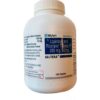Need Help? Call us at: +91 9002 1002 33 (9:00 AM - 5:00 PM)
Email us: info@altuslifecares.com
No products in the cart.
Return To ShopNo products in the cart.
Return To Shop$103.85 – $671.79Price range: $103.85 through $671.79
Aluvia Tablet (Ritonavir (50mg) + Lopinavir (200mg) is a combination of antiretrovirals medicines. It is prescribed to treat HIV (human immunodeficiency virus) infection. It boosts up the immunity to fight against HIV to manage or treat AIDS (acquired immunodeficiency syndrome).
Call : +91 9002 1002 33
| COUNTRY OF ORIGIN | India |
|---|---|
| DOSAGE FORM | Tablets |
| GENERIC NAME | Ritonavir (50mg) + Lopinavir (200mg) |
| INDICATION | Treatment of HIV infection |
| PACKAGING: | 120 Tablet in 1 Bottle |
| PACK SIZE | 1 bottle/s, 3 bottle/s, 6 bottle/s 9 bottle/s |
| MANUFACTURER | Abbott |
| COMPOSITION | Ritonavir (50mg) + Lopinavir (200mg) |
Aluvia 200mg/50mg Tablet is a combination of antiretrovirals medicines. It is prescribed to treat HIV (human immunodeficiency virus) infection. It boosts up the immunity to fight against HIV to manage or treat AIDS (acquired immunodeficiency syndrome).
Aluvia 200mg/50mg Tablet restricts the growth of HIV in the body and reduces the risk of getting HIV-related complications to improve the lifespan of an individual. The medicine should be taken with food for better efficacy. Taking these medicines regularly at the same time increases their effectiveness. A dose of this medicine should not be missed as it can affect your recovery. It is important to complete the full course of the treatment until your doctor advises you to stop it. Sudden discontinuation of the treatment may affect the potency of the medicine.
The most common side effects of this medicine are diarrhea, nausea, vomiting, and increased blood fat levels (hypertriglyceridemia and hypercholesterolemia). These side effects are generally temporary, but if they persist or become serious inform your doctor. Drinking plenty of fluid can help you to cope up with these side effects, so stay hydrated. In addition to that, avoid alcohol consumption as it may increase the intensity of the side effects.
Before starting with the treatment, you should consult your doctor if you are pregnant or breastfeeding, or have any health condition. Your doctor may suggest regular laboratory tests to check your blood counts, kidney and liver functions, and other health conditions. If you are HIV positive, you should not breastfeed or share personal belongings like razors or toothbrushes. Consult your doctor to know about safe sex methods in order to prevent transmission of HIV during intercourse.
Lopinavir 200mg + Ritonavir 50mg is not only used in adult HIV treatment but is also an essential component in pediatric HIV therapy. In this section, we will explore the dosage adjustments and considerations when administering this combination therapy to children. Understanding how to safely and effectively use Lopinavir and Ritonavir in the pediatric population is crucial for providing comprehensive care for young individuals living with HIV.
This section delves into the importance of being aware of potential drug interactions when taking Lopinavir 200mg + Ritonavir 50mg. Many medications, including over-the-counter drugs and herbal supplements, can interact with this antiretroviral therapy, affecting its efficacy or causing adverse effects. We will discuss how patients should inform their healthcare providers about all the medications they are taking to ensure a safe and effective treatment plan while minimizing the risk of undesirable interactions.
Trace the historical journey of HIV/AIDS treatments, from the early days of AZT to the latest advancements in antiretroviral drugs and their impact on the global AIDS epidemic.
Delve into how pre-exposure prophylaxis (PrEP) and post-exposure prophylaxis (PEP) serve as vital therapeutic strategies for preventing HIV transmission and safeguarding high-risk populations.
HIV medications can have side effects. This post discusses common side effects, how to manage them, and the importance of open communication with healthcare providers.
This blog post explains the “kick and kill” strategy, a promising avenue in HIV cure research that aims to flush out latent HIV and destroy it.


Alcohol

Pregnancy

Breast feeding

Driving

Kidney

Liver
| Pack Size | 1 Bottle/s, 3 Bottle/s, 6 Bottle/s, 9 Bottle/s |
|---|

Benoquin 40 Cream | Monobenzone 40%



Aziderm 10% Cream 15gm | Azelaic Acid 10%
Shipping at Discounted Price
Return Within 30 Days
Safe & Secure Payment
Contact 24 Hours Day
From: $96.15


From: $89.74
You cannot copy content of this page.
Destiny (verified owner) –
“These HIV medicines have surpassed my expectations, offering stability and a renewed sense of well-being.”
Leia (verified owner) –
“These medicines have made living with HIV a manageable and positive experience. Thankful for their effectiveness.”
Harley (verified owner) –
“I appreciate the positive impact these HIV medicines have had on my health. They’ve become a reliable source of strength.”